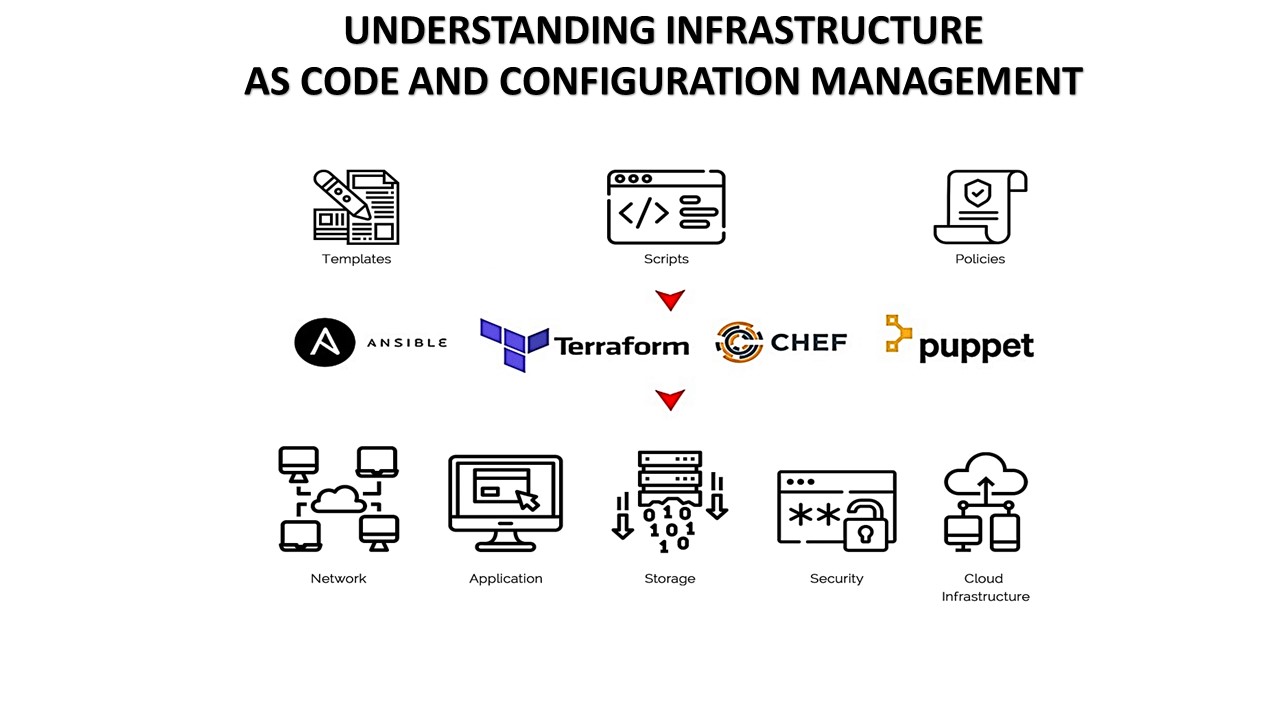Understanding Infrastructure as Code and Configuration Management
 Dhwarika Jha
Dhwarika Jha
What's the difference between Infrastructure as Code (IaC) and Configuration Management (CM)
When it comes to the cloud, Infrastructure as Code (IaC) and Configuration Management (CM) are inseparable. With IaC, a descriptive model is used for infrastructure management. To name a few examples of infrastructure: networks, virtual computers, and load balancers. Using an IaC model always results in the same setting.
Throughout the lifecycle of a product, Configuration Management (CM) ensures that the performance, functional and physical inputs, requirements, design, and operations of that product remain consistent.
About IaC and Config. Management Tools
Infrastructure as Code (IaC) and Configuration Management Tools are essential components in modern software development and infrastructure management. Let's explore what they are and how they are used.
Infrastructure as Code (IaC): Infrastructure as Code is an approach that involves managing and provisioning infrastructure resources through machine-readable definition files, rather than manually configuring them. IaC treats infrastructure as software, allowing developers and operations teams to define and manage infrastructure resources using code, which can be version controlled, tested, and deployed in a consistent and repeatable manner.
Benefits of IaC include:
Consistency and repeatability: IaC enables the creation of infrastructure environments that are consistent across different stages of development, testing, and production. It ensures that the infrastructure is reproducible, reducing the chances of configuration drift or manual errors.
Scalability and agility: IaC allows for the quick provisioning and scaling of infrastructure resources. It provides the ability to spin up or tear down infrastructure components as needed, making it easier to respond to changing demands or implement auto-scaling capabilities.
Collaboration and version control: IaC promotes collaboration between development and operations teams. Infrastructure code can be stored in version control systems, enabling collaboration, code reviews, and the ability to roll back changes if necessary.
Documentation and visibility: Infrastructure code serves as documentation for the infrastructure setup, making it easier to understand and replicate the environment. It provides visibility into the infrastructure configuration, making it easier to audit and troubleshoot issues.
Configuration Management Tools: Configuration Management Tools are software solutions that automate the management and configuration of infrastructure resources. These tools work in conjunction with IaC to ensure that the defined infrastructure state is deployed and maintained consistently.
Popular configuration management tools include:
Ansible: Ansible is an open-source tool that uses a declarative language to define infrastructure configuration. It is agentless, meaning it doesn't require an additional software component on the target machines. Ansible uses SSH or WinRM to connect to the target systems and execute the defined configuration tasks.
Chef: Chef is an open-source configuration management tool that uses a Ruby-based language to define infrastructure configuration. It follows an "Infrastructure as Code" approach and uses a client-server architecture. Chef clients are installed on target machines and connected to a Chef server to fetch and apply the desired configuration.
Puppet: Puppet is an open-source configuration management tool that uses a declarative language to define infrastructure configuration. It follows a client-server architecture and uses Puppet agents on target machines to fetch and apply the configuration defined on the Puppet master server.
Terraform: Although primarily an IaC tool, Terraform can also perform some configuration management tasks. It allows for the provisioning and management of infrastructure resources across multiple cloud providers and on-premises environments. Terraform uses a declarative language to define the desired infrastructure state and can integrate with other configuration management tools for more advanced configuration management capabilities.
These tools provide features such as infrastructure provisioning, package installation, service configuration, and more. They automate the deployment and management of infrastructure, making it easier to maintain consistency and enforce desired configurations.
It's important to note that the choice of IaC and configuration management tools depends on the specific requirements, the infrastructure environment, and the preferences of the development and operations teams.
Differences between both with suitable examples
Differences between Infrastructure as Code (IaC) and Configuration Management Tools with some examples to illustrate their distinctions.
Infrastructure as Code (IaC): IaC focuses on defining and managing infrastructure resources through code. It treats infrastructure as software and allows for the provisioning and configuration of infrastructure components using machine-readable definition files. IaC tools enable the creation and management of infrastructure environments in a consistent and repeatable manner.
Example: Suppose you're using a tool like Terraform, an IaC tool. You define your desired infrastructure state using Terraform configuration files (written in HashiCorp Configuration Language, or HCL). These files specify the infrastructure resources you want to provision, such as virtual machines, storage, networks, and more. You can then use Terraform to create, update, or destroy the infrastructure by executing the defined configurations. The focus is on creating and managing the infrastructure itself, defining the desired state and allowing the tool to bring it into existence.
Configuration Management Tools: Configuration management tools, on the other hand, focus on automating the management and configuration of infrastructure resources. They ensure that the defined infrastructure state is deployed and maintained consistently across multiple systems. These tools handle tasks such as package installation, service configuration, file management, and more.
Example: Let's consider Ansible, a configuration management tool. With Ansible, you define tasks in YAML files that describe the desired configuration for your infrastructure. These tasks can include actions like installing software packages, configuring files, and starting services. Ansible connects to target systems over SSH or WinRM and executes the defined tasks on those systems. The emphasis is on configuring and managing the software running on the infrastructure rather than provisioning the infrastructure itself.
What are the most common IaC and Config Management Tools?
The most common Infrastructure as Code (IaC) and Configuration Management tools used in the industry include:
Terraform: Terraform is a widely adopted IaC tool developed by HashiCorp. It allows for the provisioning and management of infrastructure resources across various cloud providers and on-premises environments. Terraform uses declarative language to define the desired infrastructure state and supports a wide range of infrastructure components.
Ansible: Ansible is a popular open-source configuration management tool. It uses declarative language and follows a "Infrastructure as Code" approach. Ansible is agentless, meaning it doesn't require an additional software component on the target machines. It uses SSH or WinRM to connect to the target systems and execute the defined configuration tasks.
Chef: Chef is an open-source configuration management tool that uses a Ruby-based language to define infrastructure configuration. It follows a client-server architecture, where Chef clients are installed on target machines and connected to a Chef server to fetch and apply the desired configuration.
Puppet: Puppet is another widely used open-source configuration management tool. It uses declarative language to define infrastructure configuration. Puppet follows a client-server architecture and employs Puppet agents on target machines to fetch and apply the configuration defined on the Puppet master server.
CloudFormation: CloudFormation is an Infrastructure as Code tool provided by Amazon Web Services (AWS). It allows you to define and provision AWS resources using JSON or YAML templates. CloudFormation is specific to the AWS ecosystem and integrates well with other AWS services.
Azure Resource Manager (ARM) Templates: ARM Templates are Infrastructure as Code tools provided by Microsoft Azure. They allow for the definition and provisioning of Azure resources using JSON templates. ARM Templates are specific to the Azure platform and provide comprehensive coverage of Azure resources.
These tools are just a few examples of the most commonly used IaC and Configuration Management tools. Each tool has its own strengths, features, and ecosystem support. The choice of tool depends on factors such as the specific infrastructure environment, cloud provider preference, desired features, and the skill sets of the development and operations teams.
Subscribe to my newsletter
Read articles from Dhwarika Jha directly inside your inbox. Subscribe to the newsletter, and don't miss out.
Written by
